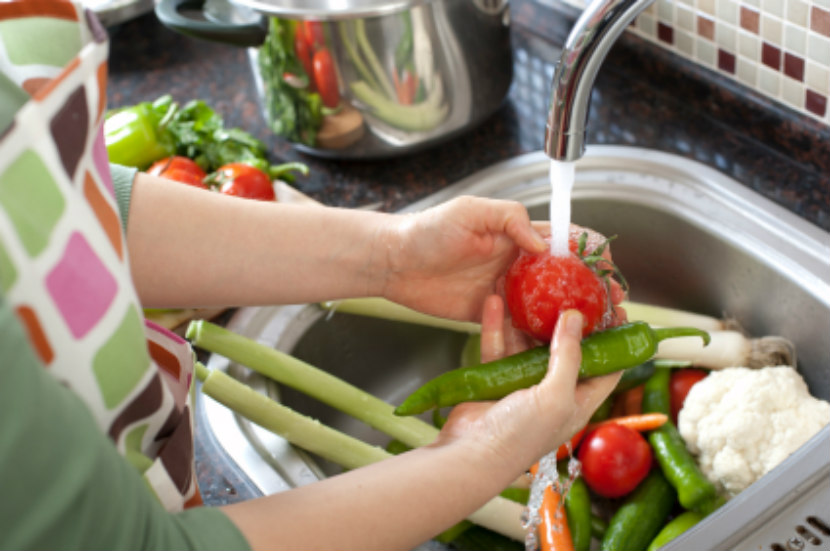
Knowing how to wash different types of vegetables and fruit the right way will keep your food tasting great and safe to eat.
General tips for washing vegetables and fruit
Most fresh fruit and vegetables have a natural protective coating so it’s a good idea to wash them under water just before you are ready to eat or cook them. If you wash them ahead of time, it will speed up how fast they spoil. Leafy greens can be washed and stored a few days before you use them.
The best way to wash vegetables and fruit is under cold running water. You do not need special products, soaps or vinegar. These can leave an aftertaste and don’t kill bacteria or mould. Bonus! Watch the video to see this information in action.
Before you start – Wash your hands
Wash your hands with hot water and soap for at least 20 seconds before and after handling fresh produce.
Washing leafy green vegetables
Examples of leafy greens are kale, lettuce, Swiss chard, rapini, cabbage and pre-bagged greens like baby spinach.
- Wash all leafy green vegetables, including pre-bagged greens under cold running tap water.
- For leafy vegetables, such as lettuce and cabbage, remove the outer leaves first. Throw away any wilted or discoloured leaves.
- Rinse leafy vegetables in a colander (strainer), drain (or use a salad spinner) and pat dry with a paper towel or clean tea towel.
- Store in clean paper towels or a clean tea towel in a sealed plastic bag in the fridge. Use within a week.
Tip: Washing your green leafy vegetables as soon as you bring them home will make them more convenient to use in salads, stir fries and other dishes when you need them.
Washing fruit and vegetables with a rind
Examples of foods with a rind are cantaloupes, oranges, mango, melons, pineapple, carrots, potatoes and squash.
- The reason you wash vegetables and fruit with a rind is because this prevents bacteria on the rind or peel from going into the food when you slice it.
- Use a soft, clean produce brush to scrub vegetables and fruit under cold running water. Then pat dry.
Washing mushrooms
- The best way to wash all types of mushrooms is to wipe them clean with a damp cloth
- You can also rinse them quickly in cool water. It’s not a good idea to soak mushrooms because they will absorb water, which will make them spoil faster.
- Once the mushrooms are clean, pat dry with a clean tea towel.
Washing berries
Examples of berries are strawberries, blueberries, blackberries and raspberries.
- Wash berries just before you eat them otherwise they will spoil quickly.
- To wash berries, rinse them in a colander (strainer) and pat dry with a paper towel or clean tea towel.
Stay food safe: Clean all surfaces and utensils with hot water and soap, including cutting boards, counter tops, peelers and knives that touch fresh fruit or vegetables.
Test your food safety knowledge with our True or False Food Safety Quiz.
Fruit and vegetable recipes to try:
Almond Butter Spiced Apple
Avocado and Fruit Salad with Basil and Honey
Barley and Lentil Salad with Kale, Apples, Almonds and Feta
Carrot and Apple Salad
Minestrone Soup Made Easy
How can a dietitian help?
Dietitians use the most up-to-date science and translate it into practical guidance that you can use to make healthy lifestyle and food choices. Dietitians can support you throughout many phases of your life from pregnancy to eating well when you are older. Counselling sessions with a dietitian can also help you to prevent and treat some health conditions like diabetes and heart disease. Many employee health benefit plans cover dietitian services. Connect with a dietitian today!
Bottom line
Properly washing your fresh vegetables and fruits before cooking or eating is important. Follow these tips to stay food safe and prevent getting sick.
You may also be interested in:
Vegetable and fruit food safety facts
Video: How to store fruit to keep them fresh
Video: How to store vegetables to keep them fresh
Top 5 reasons to see a dietitian
This article was written and reviewed by dietitians from Dietitians of Canada. The advice in this article is intended as general information and should not replace advice given by your dietitian or healthcare provider.
Last Update – July 24, 2023